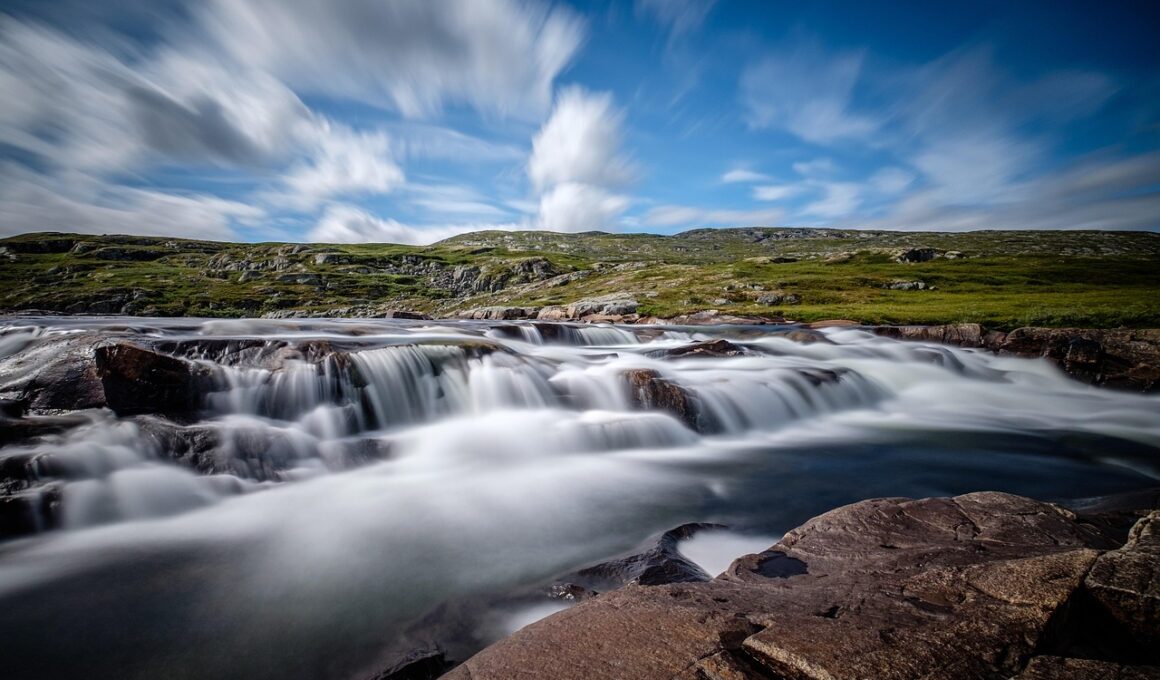Water Storage and Conservation Tips in the Wild
Effective water storage and conservation are critical skills for anyone venturing into the wild. In survival situations, the quality and amount of water you can store can determine your success. First, always carry a reliable container, such as a durable water bottle or hydration pack. Next, be aware of various sources of water, including rivers, lakes, and even dew that collects on leaves. Techniques like filtering or boiling are essential to purify the water collected. As you navigate, ensure you are choosing clean and safe sources; this may require some knowledge of your surroundings. Use a water filtering system or purification tablets when necessary. Additionally, consider solar stills, which can extract moisture from the soil or vegetation. Keep in mind that conserving your water supply is equally as important as collecting it. Ration your water wisely by drinking in small sips and minimizing physical exertion to prevent dehydration, especially in hot conditions. Understanding how to store and utilize water effectively enhances your survival chances in outdoor adventures. Remember to plan ahead and utilize these strategies wherever your journey takes you.
When setting up your camp, one of the first considerations should be water conservation. Establish your campsite near natural water sources to make access easier. However, it’s important to avoid pollution by keeping your distance from the water’s edge. Try using tarps or containers to catch rainwater; these methods allow you to store more water efficiently. Keep your containers covered to prevent evaporation or contamination. Including a sand or charcoal filter can aid in purifying questionable water sources. Furthermore, if your adventure lasts several days, utilize solar energy to create a makeshift water purification system. It is critical to keep your drinking water separate from dirty water used for washing or cooking. Flowing water sources can sometimes be less contaminated, but verify before relying on them. Also, remember to pack out any trash or waste to maintain the cleanliness of your chosen area. Staying mindful of your environmental impact ensures that others can enjoy the same resources in future excursions. Always prioritize maintaining a sustainable approach to water use, which contributes to the enjoyment for all wilderness enthusiasts and protects the ecosystems around you.
Techniques for Water Collection in the Wild
Water collection techniques greatly enhance your ability to survive in the wilderness. Knowing various methods is invaluable. A common and effective approach is digging for water. By digging shallow holes in sandy or clay soil, you may access groundwater that often fills these depressions. Furthermore, gathering dew early in the morning is another efficient way to collect fresh water. You can do this by laying out a clean cloth or a tarp overnight and squeezing out the absorbed moisture in the morning. If available, use a large leaf to funnel rainfall or condensation into your container. Additionally, you can utilize plants to extract moisture; simply cut the tops of certain plants and collect the liquid that oozes out. For a more advanced technique, consider building a rainwater harvesting system using improvised gutters and large containers. Knowing which local plants provide potable water and which do not is crucial, as some can be toxic. Constantly observe your environment for potential water sources while on the move, adding flexibility and resilience to your survival skills in the field. Continuously enhance your knowledge of these skills for a safer outdoor experience.
Staying hydrated is vital during outdoor adventures and contributes significantly to overall performance and endurance. As dehydration sets in, your physical capabilities diminish, which could lead to dangerous situations. Therefore, understanding your daily water needs is essential. Generally, you should aim to drink about two to three liters of water per day, depending on exertion levels and environmental conditions. Remain mindful of symptoms of dehydration, including fatigue, dizziness, and dry mouth. Adjust your drinking habits based on activity levels and weather. Drinking small amounts regularly can help maintain hydration, rather than consuming large quantities all at once. Pay attention to meals as well; food can contribute to your water intake. Fruits and vegetables typically contain more water and provide necessary nutrients. Additionally, incorporate electrolyte-rich beverages to replenish lost salts due to sweat. Always strive to have ample hydration supplies and pack extra if possible. During long hikes or exploration, this becomes an essential part of preparation. A well-planned hydration strategy fosters a safer and more enjoyable outdoor experience by keeping you alert, focused, and healthy throughout your journey in nature.
Long-Term Water Survival Strategies
In extended survival situations, having long-term water strategies can increase your chances of remaining hydrated. One effective strategy involves building rainwater catchment systems, from simple tarps to complex systems utilizing tubing. These can capture precipitation during rainfall events and store large quantities of clean water. After establishing a catchment system, consider incorporating filters to ensure the water remains potable for longer storage. Understanding the biology and ecology of your area will aid immensely; learn about native plants and their water-storing capabilities. For example, the roots of some types of cactus can provide vital hydration. Explore local regulations regarding water collection methods to avoid legal issues. In addition, maintain an awareness of evaporation rates in warmer climates, where storing water in shaded areas decreases loss. If employing stored water that has settled for a long time, always purify before consumption. Implementing these strategies enhances resilience against drought or shortages in water supply. Moreover, flexibility in tactics can allow for adaptability to changing weather conditions, ensuring survival in diverse terrains. Prioritize consistent water supply management to sustain yourself and your companions in the wilderness through careful planning and unconventional strategies.
Additionally, be mindful of the importance of proper sanitation in your water management practices. When outdoors, ensure that you do not pollute your water sources with waste or contamination. Use biodegradable soaps and ensure any cleaning processes are done at least 200 feet away from water sources. Proper laundering techniques can help reduce your environmental footprint while maintaining hygiene. Use portable waste bags for solid waste and pack them out when necessary. Metal containers or specially designed portable toilets can also be beneficial depending on your situation. When washing, always prioritize minimizing soap usage, opting for methods that require less water overall. Additionally, when cooking with limited water, plan meals that require minimal liquid while still being nutritious. Simple one-pot meals can conserve water and reduce mess, making cooking easier. Incorporating dried ingredients that require less rehydration can also be effective. Lastly, educating yourself about local wilderness survival laws and etiquette fosters deeper respect for the environment by following guidelines and practices that protect water sources. Together, these efforts promote a sustainable approach to outdoor adventures, ensuring you will positively impact even the most fragile ecosystems you encounter.
Conclusion
In conclusion, mastering water storage and conservation in the wild is an indispensable skill for any adventurer. These practical techniques not only ensure hydration but also contribute positively to the environment. Begin by packing effective containers, understanding local water sources, and employing innovative methods for collection and purification. Emphasize conservation through responsible water usage, and remain vigilant about sanitation practices. Long-term strategies, such as rainwater harvesting and using plants for moisture, can sustain you in extended survival scenarios. Always educate yourself on various techniques and practices that reduce environmental impact while ensuring personal safety. Remember to adapt your strategies based on changing circumstances, and embrace the unpredictability of the wilderness. Adventure is about exploration and growth, so while refining your survival skills, enjoy the insights that nature offers. By implementing these water storage and conservation tips, you enhance your outdoor experiences, maximizing your capability to enjoy the beauty of the wild. Make water management a priority, allowing it to be a powerful tool in elevating your survival techniques for future adventures in nature, fostering a deeper connection between you and the great outdoors.
As you plan your next outdoor adventure, remember that your efforts in water storage and conservation are critical. Any adventurer must be aware of their water needs and the best methods to secure them. Each of these tips will empower you to enhance your wilderness experience significantly. Prepare with knowledge, appropriate gear, and a commitment to sustainability. With practice and patience, these skills will become second nature, allowing you to focus more on the experience rather than worrying about hydration. By being proactive and informed, you can enjoy the beauty of nature safely while protecting it for future generations. Integrating efficient water solutions leads to maximizing your comfort and safety levels in the wild. Use diverse techniques and adopt a range of strategies for your adventures, as this will keep you well-prepared for unexpected circumstances. Embarking on outdoor pursuits with a thoughtful approach to water management can truly elevate your experience in nature. Enrich your journey and cultivate a deeper appreciation for the delicate balance of ecosystems while thriving in the wilderness.


